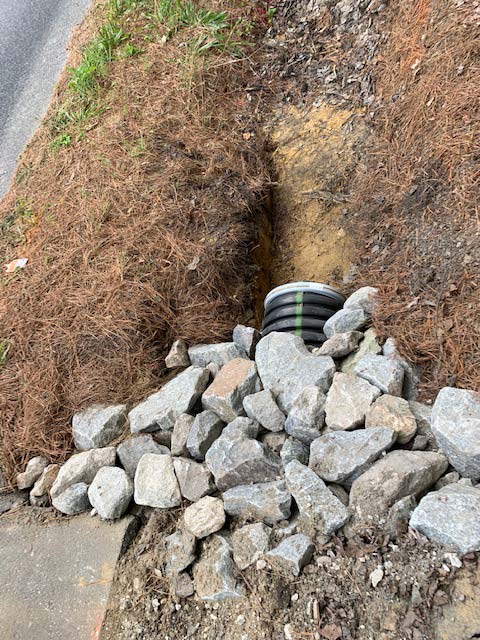Culvert Installment Facilitated: Step-by-Step Overview for Success
From selecting the ideal culvert size to incorporating correct water drainage actions, each step in the installation process plays an essential function in the performance and long life of the culvert system. Remain tuned to uncover the crucial steps and factors to consider that can make culvert installation a seamless and successful endeavor.
Selecting the Right Culvert Size
Picking the appropriate culvert dimension is important for making sure reliable water flow and structural integrity in culvert installation projects - Pad Construction. The dimension of the culvert directly influences the flow capacity of water through the structure. A culvert that is also small can cause flooding and overflow, while one that is too large may result in reduced water speed, possibly causing debris build-up and blockages
To determine the ideal culvert dimension, factors such as the watershed location, peak flow rates, and hydraulic performance need to be very carefully taken into consideration. Calculations based on these criteria aid in picking a dimension that can sufficiently handle the anticipated water quantity while lessening the threat of obstructions and structural failing.
It is necessary to seek advice from design standards and standards to make certain that the picked culvert size fulfills the project demands and regional guidelines (Pad Construction). By choosing the appropriate culvert dimension, job managers can maximize water circulation, stop potential problems, and boost the total efficiency and longevity of the culvert setup
Preparing the Installation Website
Effective culvert installation necessitates careful preparation of the setup website to guarantee optimum structural assistance and functionality. Prior to commencing the installation procedure, it is essential to remove the site of any kind of particles, plants, or blockages that might hamper the culvert's positioning. Making sure a level foundation is important for the correct positioning and security of the culvert. This may entail rating the website to produce a smooth, even surface that can appropriately support the weight of the culvert and any kind of anticipated tons. Additionally, correct compaction of the dirt beneath the culvert is required to avoid resolving or moving over time.
Additionally, it is essential to think about variables such as dirt structure, groundwater levels, and environmental effects when preparing the installment website. Conducting a complete website evaluation can aid recognize any type of prospective obstacles or risks that may influence the culvert's performance. By making the effort to prepare the installment website properly, you can assist assure an effective culvert setup that fulfills structural needs and makes sure long-term capability.
Putting the Culvert Appropriately

The grade at which the culvert is placed is essential for keeping a correct incline for water flow. A progressive slope aids avoid pooling and advertises effective water drainage. Furthermore, the culvert needs to be oriented correctly to make certain that the inlet and outlet are in the proper areas. This positioning is important for the culvert to operate successfully in managing water flow.
Backfilling and Compacting the Soil
Correct backfilling and compaction of the dirt around the culvert is important to guarantee stability and prevent prospective problems in the future. When the culvert is appropriately positioned, the next critical step is to backfill the location around it with appropriate material. The backfill product need to be without rocks, debris, and organic issue to prevent damage to the culvert. It is suggested to utilize granular material such as sand or gravel for backfilling, as it offers good drain and compaction homes.
After putting the backfill product, it a knockout post is necessary to small it in layers of consistent thickness. Making use of a compactor or a mechanical tamper, compact the soil delicately to prevent damaging the culvert. Compaction assists in lowering the possibilities of negotiation and guarantees uniform support around the culvert. It is crucial to small the soil equally on all sides of the culvert to see it here preserve its architectural honesty.
Correct backfilling and compaction not just give security to the culvert but likewise help in avoiding soil erosion and preserving the durability of the culvert system.
Making Certain Correct Water Drainage Combination
Integrating effective drain options plays an important role in the overall functionality and durability of culvert installments. Appropriate drain assimilation is crucial for managing water flow, stopping disintegration, and ensuring the structural stability of the culvert system. To accomplish this, it is essential to make an extensive drain strategy that thinks about factors such as the quantity of water anticipated, the topography of the location, and the sort of dirt existing.

Furthermore, integrating features like disintegration control actions, such as riprap or greenery, can better boost the effectiveness of the water drainage system. By meticulously intending and applying these drain options, culvert installments can operate effectively and stand up to the test of time.
Conclusion
To conclude, appropriate culvert setup is vital for preserving efficient drain systems. By selecting the right culvert dimension, preparing the installment site, positioning the culvert correctly, backfilling and condensing the dirt, and view publisher site guaranteeing appropriate drainage combination, success can be accomplished. Adhering to these steps will certainly assist make sure the longevity and efficiency of the culvert, inevitably adding to the general success of the water drainage system.